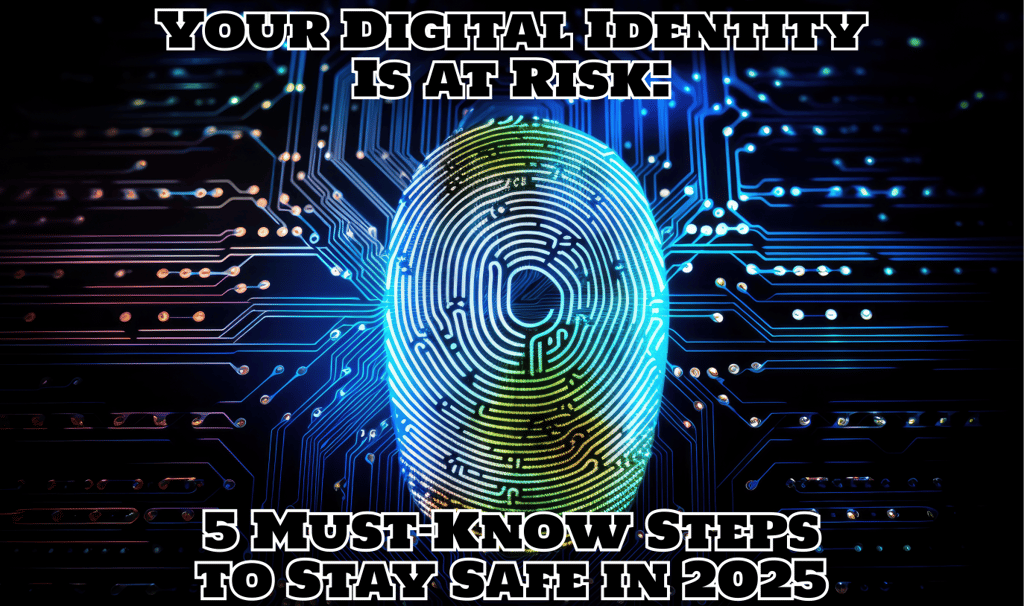Your Digital Identity Is at Risk: 5 Must-Know Steps to Stay Safe in 2025
Cyber threats are advancing fast, and your personal data is a prime target. From data breaches and phishing scams to weak passwords, cybercriminals are refining tactics to steal identities and financial information. Protect yourself by enabling Multi-Factor Authentication (MFA), using strong, unique passwords managed securely, and avoiding suspicious emails and links. Limit the personal information you share online and keep all devices updated with the latest security patches. Digital security is no longer optional—it’s essential. Stay alert, proactive, and a step ahead of cybercrime in 2025. Your identity and financial safety depend on it. #CyberSecurity #MFA #OnlineSafety
CYBER SECURITY
Toz Ali
3/29/20253 min read


Imagine waking up one morning to find your bank account drained, your social media accounts hijacked, or even your personal information being sold on the dark web. The digital world offers unparalleled convenience, but it also exposes us to ever-evolving cyber threats. With hackers developing more sophisticated techniques each year, securing your online identity is no longer optional—it's essential.
This blog will uncover the most pressing security threats in 2025 and provide five critical steps to protect your personal and professional digital footprints. Whether you're an everyday internet user or a business professional, these insights will help you stay ahead of cybercriminals and safeguard your digital presence.
Real-World Problems
Data Breaches and Identity Theft
Cybercriminals frequently exploit weak security measures to access personal and financial information from organizations and individuals. Major corporations and even government entities have suffered breaches that exposed millions of users' sensitive data, including Social Security numbers, banking details, and passwords. Once stolen, this information can be sold on the dark web, leading to financial fraud, unauthorized transactions, and identity theft.
Phishing and Social Engineering Attack
Phishing scams have become increasingly sophisticated, using fake emails, text messages, and websites that mimic legitimate institutions like banks, tech companies, or even employers. Attackers trick users into revealing login credentials, credit card numbers, or other sensitive data. Social engineering tactics, such as impersonation and pretexting, manipulate victims into granting unauthorized access, often bypassing technical security controls. High-profile data breaches often begin with a single employee falling for a phishing scam, highlighting the importance of vigilance.
Weak Passwords and Credential Stuffing
Many individuals still use weak or reused passwords across multiple accounts, making them easy targets for cybercriminals. Credential stuffing attacks leverage leaked username-password combinations from previous breaches to gain access to other accounts. If a single password is compromised, hackers can infiltrate multiple platforms, leading to severe security breaches in both personal and professional spaces. Studies show that over 60% of people still reuse passwords, making them highly susceptible to this attack method.
Privacy Invasion via Social Media
Oversharing on social media platforms can expose personal details that cybercriminals use for identity theft, fraud, or even physical threats. Attackers may gather information from public profiles, including birthdays, locations, and family details, to craft convincing scams or gain unauthorized access to accounts. Furthermore, businesses collecting user data without robust security measures can put users at risk of data leaks and misuse. In recent years, deepfake technology has also been used to create realistic but fake videos or audio clips, causing reputational damage.
Insecure Devices and Unprotected Networks
Many users neglect the security of their personal and work devices, leaving them vulnerable to cyberattacks. Outdated software, unpatched vulnerabilities, and the use of public or unsecured Wi-Fi networks can allow hackers to intercept data, install malware, or gain control over a device remotely. Ransomware attacks, where hackers encrypt files and demand payment, have surged in recent years, affecting both individuals and businesses. Public Wi-Fi hotspots in coffee shops, airports, and hotels are prime targets for hackers looking to intercept sensitive data.
5 Key Takeaways for Digital Safety
Enable Multi-Factor Authentication (MFA)
Strengthen your accounts by adding an extra layer of security beyond passwords, such as biometric verification, authentication apps, or hardware security keys. MFA significantly reduces the chances of unauthorized access, even if your password is compromised.
Use Strong and Unique Passwords
Create complex passwords for each account and use a password manager to store them securely. Avoid reusing passwords across multiple accounts, and consider passphrases that combine random words for added security. Changing passwords regularly and enabling alerts for unauthorized login attempts can further enhance security.
Be Wary of Phishing Attempts
Cybercriminals often disguise malicious links in emails, texts, and social media messages. Avoid clicking on unfamiliar links or downloading attachments from unknown senders. Verify the authenticity of requests by contacting the company directly through their official website. If an email or message seems urgent or too good to be true, double-check its authenticity before responding.
Limit Personal Information Sharing
Review and adjust privacy settings on social media and other online platforms to limit who can see your personal information. Be mindful of what you post online, as cybercriminals can use small details—like your pet’s name, birthday, or workplace—to guess passwords or security answers. Consider using aliases or limiting the visibility of personal details to close contacts only.
Keep Your Devices and Software Updated
Regularly update your operating systems, applications, and security software to patch vulnerabilities and prevent exploits. Enable automatic updates whenever possible, and install reputable antivirus and anti-malware programs. Avoid using public Wi-Fi for sensitive transactions, and use a Virtual Private Network (VPN) to encrypt your data when browsing online.
Thoughts
Cyber threats are evolving, but so can your defenses. By taking proactive steps to secure your digital identity, you can protect yourself from cybercriminals, fraudsters, and data breaches. Digital security isn’t just about protecting data—it’s about protecting your finances, reputation, and peace of mind. Implement these security measures today and stay one step ahead of cyber threats in 2025.
Stay vigilant, stay informed, and stay secure!
